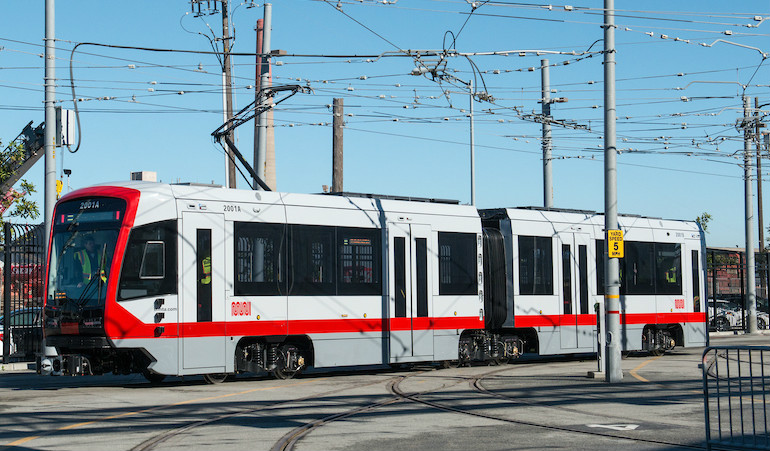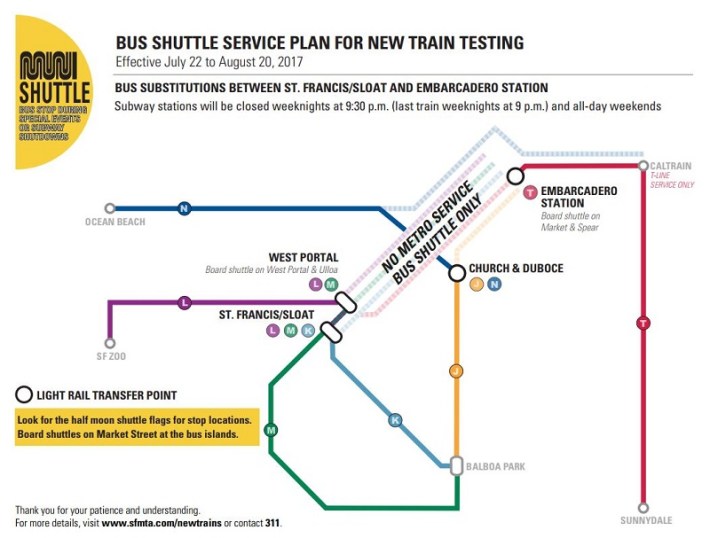Transit Watchers Question Need to Close Subway
5:19 PM PDT on July 18, 2017

One of Muni’s new Siemens’ LRVs. Photo: SFMTA
The San Francisco Municipal Transportation Agency (SFMTA) infuriated transit advocates when it announced on Saturday that it will close the entire Muni subway, from Embarcadero to West Portal, every weekend and after 9:30 p.m. during the week, for the next four or five weeks. The closures, which start this weekend, are part of a testing program for its new light-rail vehicles (LRV).
"This is just unacceptable," said Rachel Hyden, Executive Director of the San Francisco Transit Riders, about the short notice. Many advocates, including Hyden, also question the necessity of the closures in the first place.
First the details from the SFMTA announcement:
The testing requires the Muni subway to close early on weeknights and over the weekends for four weeks. Testing will begin with the start of service on Saturday, July 22 (approximately 7 a.m.) and continue until the end of regular service on Sunday, Aug. 20 (approximately 1 a.m., Monday).
Replacement buses will be provided. Here's a map of the closures.

Tom Radulovich, Executive Director of the advocacy group Livable City and a former BART Director with over 20 years experience, in an email to Streetsblog, also had questions. "Muni has fewer options than BART does--it has no test track, and it only uses computer control in the Market Street subway. However closing down the entire subway every weekday evening and every weekend for over a month to test only five trains does seem like an extraordinary imposition on riders. Testing ought to take place overnight during the regular maintenance window."
At today's SFMTA board meeting, Director Ed Reiskin described the closures as part of an "exciting point in the development in our new vehicles ... we are in the final stage of rigorous testing and acceptance process. We’re in the home stretch, which is exciting." But he said this final stage requires closing the subway. "The most complicated part is testing with the automated system in the subway--in order to fully test the system to make sure everyone can talk with each other, we will need to shut down the subway for that testing to take place."
Streetsblog reached out to SFMTA to try and find out exactly why testing can't be done during normal maintenance hours, from 1 to 5 a.m. "One testing requirement is to run the train for 1,000 hours to really 'kick the tires' and make sure they are ready for service. We have to follow and meet several California Public Utilities Commission (CPUC) guidelines/requirements before these trains can go into service," wrote Erica Kato, a spokesperson for SFMTA. "A four-hour closure window wouldn’t be feasible to getting these much-needed trains on the streets and in-service."
She also wrote that "... this testing window also allows us an opportunity to complete upgrades to the emergency 'blue light' phone consoles in the subway tunnel..."
Acknowledging that it would obviously take longer to make the 1,000-hour threshold, Streetsblog asked Kato to explain exactly why it wasn't "feasible" to do the testing in four-hour increments. Streetsblog also asked if at least some of the 1,000-hours required by the CPUC can be done outside the tunnel and/or during revenue operations, but outside of peak hours, when there's space for test trains. SFMTA had not replied at the time of this post, but Streetsblog will update accordingly.
UPDATE: SFMTA confirms that the 1,000 hours do not have to be done entirely in the tunnel. A spokesman also wrote that the four-hour maintenance window translates to only two hours of actual testing time once the agency gets done with system sweeps required to shut down the subway. He added that some of the testing of the new trains, such as emergency braking and hard accelerations, can only be done with the system closed down.
"Muni needs to test and certify their new Siemens light rail vehicles to be sure. But their impact to revenue service--shutting down whole weekends and evenings after 9:30 p.m.--is extreme and outside of industry best practices." said Dennis Lytton, a Bay Area transportation writer and consultant with significant rail transit operations and policy experience. "Other peer transit properties--such as Washington, D.C. Metrorail, Los Angeles Metro Rail, and the New York City Subway to name a few--are currently testing new trains and find ways to not so thoroughly reduce revenue service and impact the communities they serve."
Meanwhile Reiskin, in response to a question from SFMTA Chairwoman Cheryl Brinkman, said this testing would not be necessary every time the agency accepted more new LRVs, beyond this first batch of five. "Once the control system is safety certified we don’t need to certify new vehicles."
But Lytton remained unconvinced that suspending revenue service is necessary even for this initial batch. "It honestly strikes me as just operationally lazy."
"We're really frustrated. It feels like they planned this in a vacuum," said Hyden. "This shouldn't be a thing--SFMTA should expend every and any option to avoid this kind of impact ... they think of the rider last."
Stay in touch
Sign up for our free newsletter
More from Streetsblog San Francisco
Commentary: Make Bay Area Transit Seamless as Condition of New Funding
SFMTA Starts West Portal Outreach
Agency presents plans to block traffic from crossing in front of the train station




